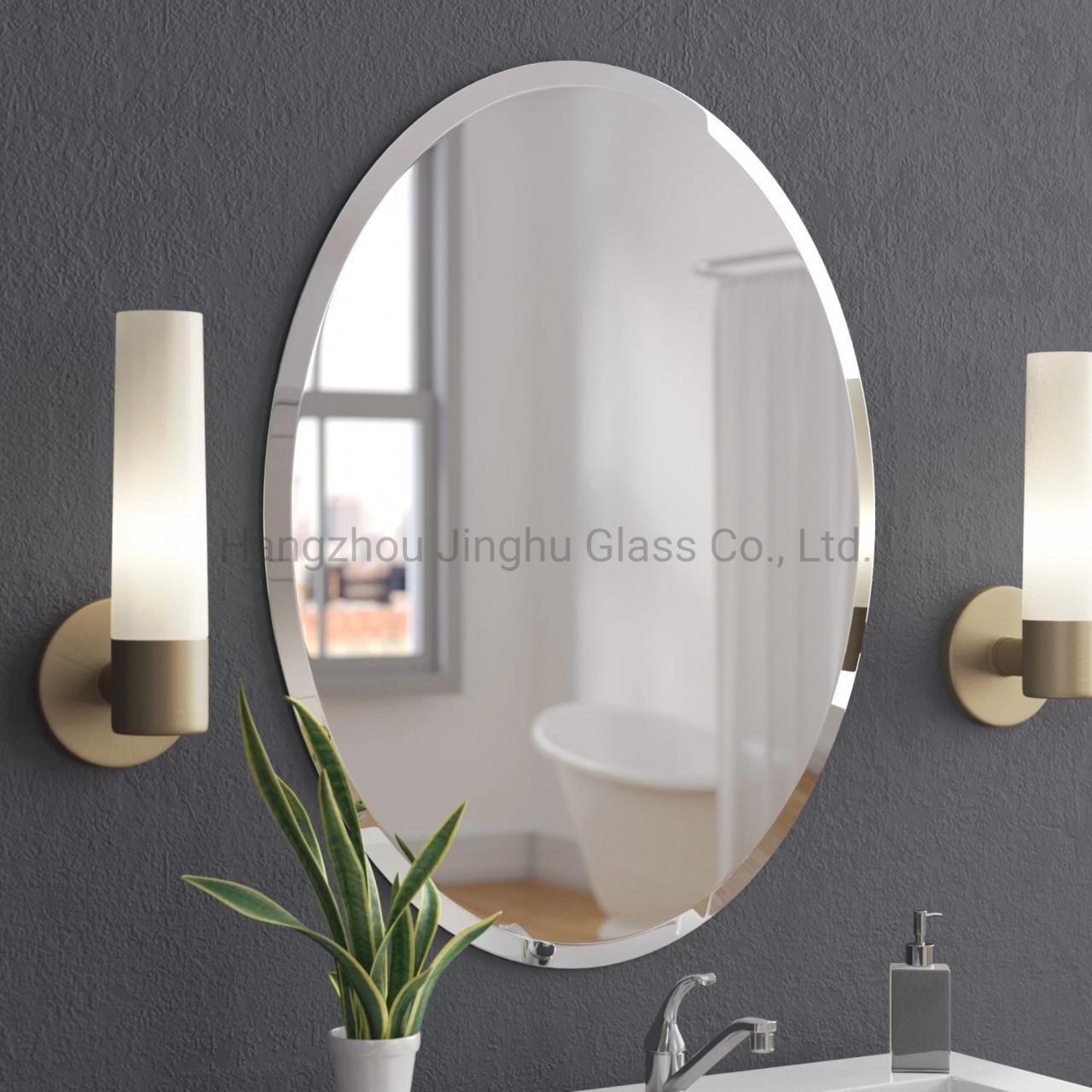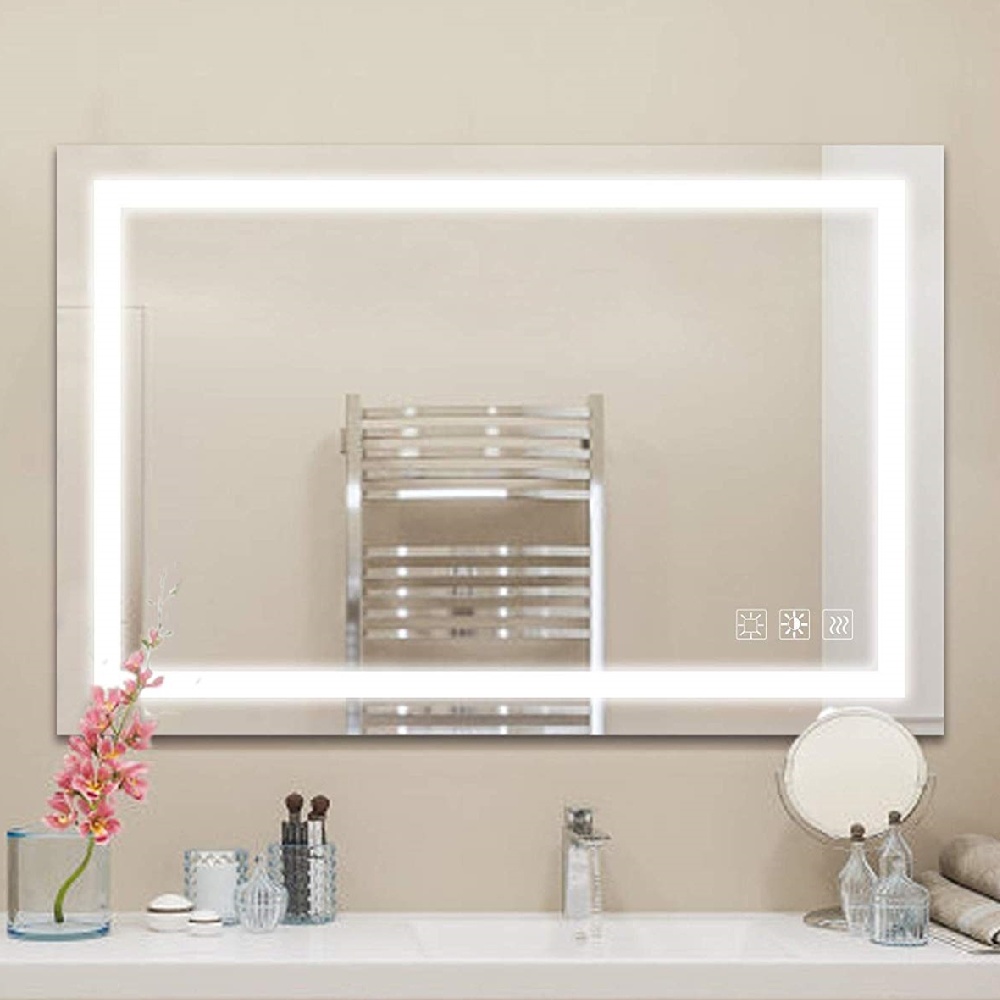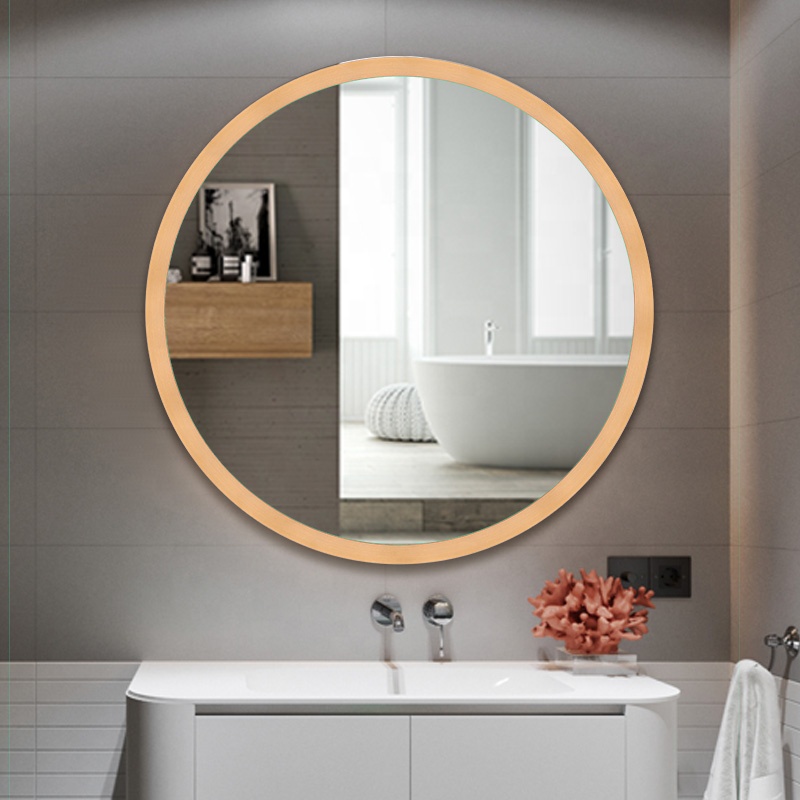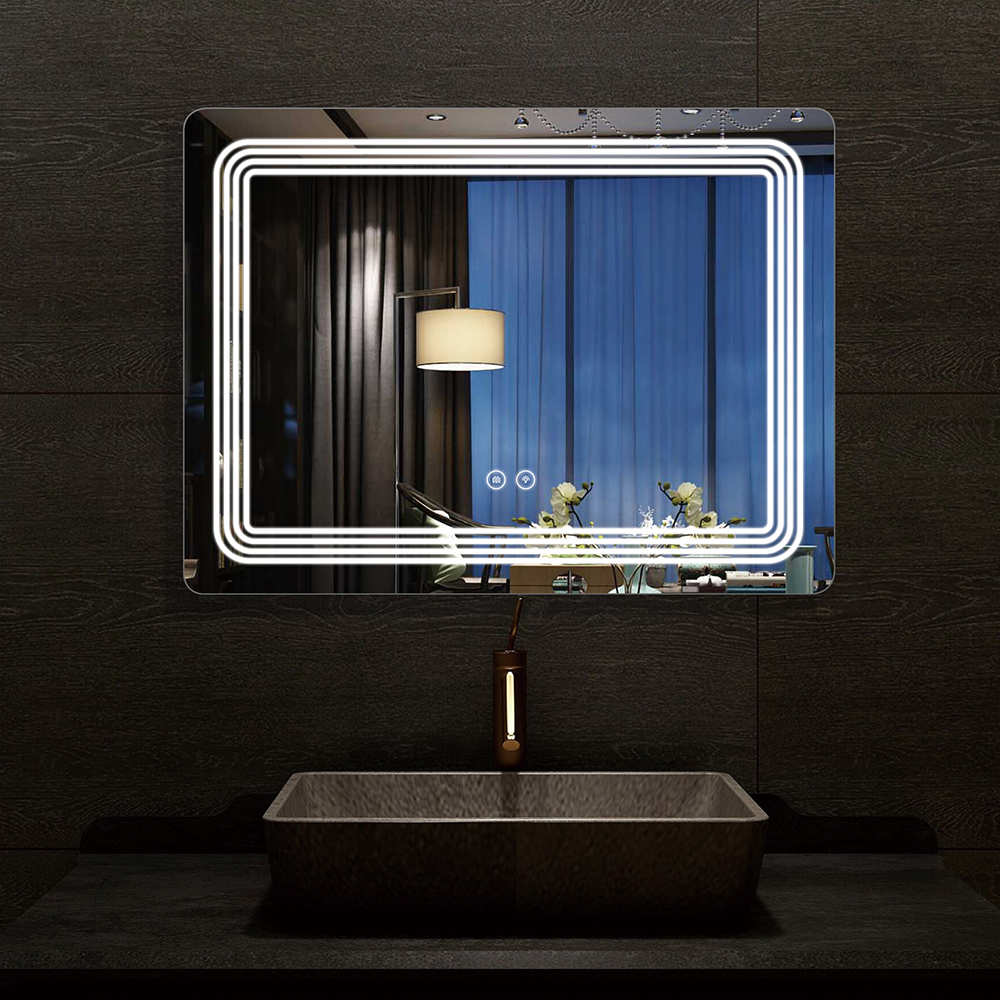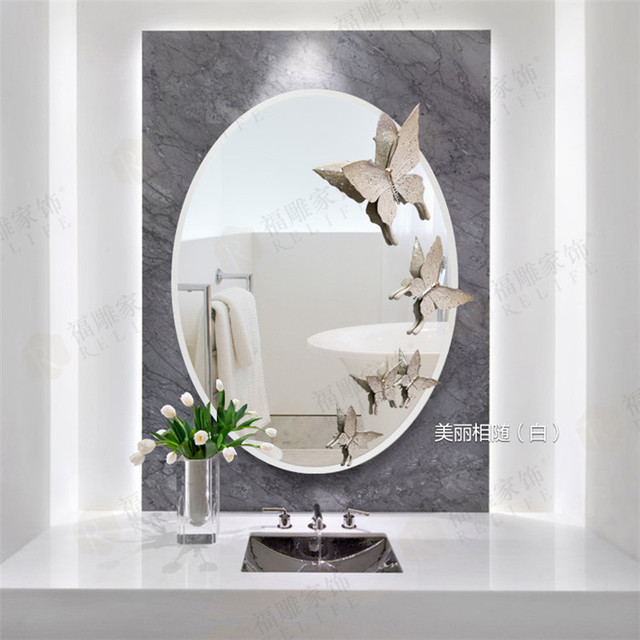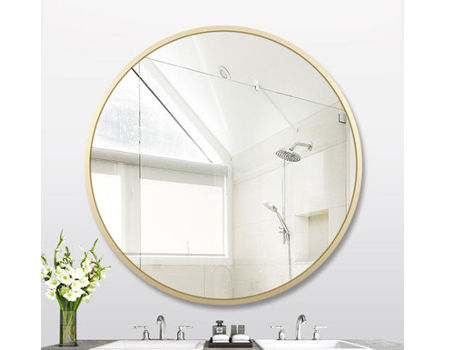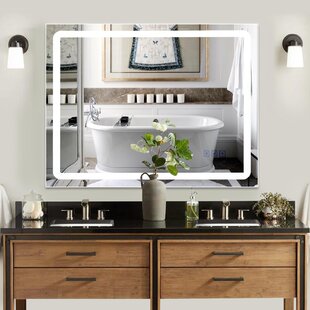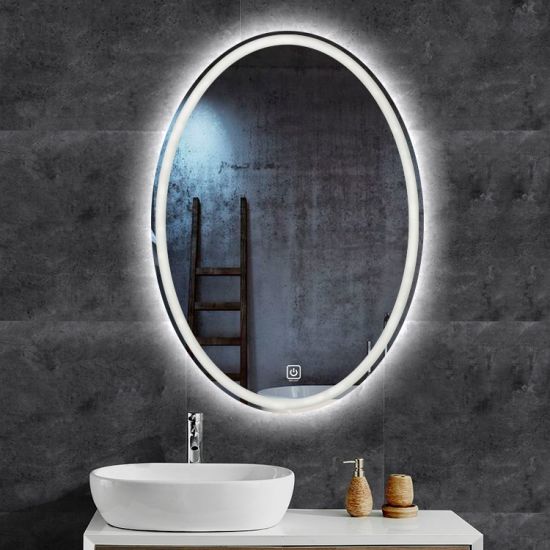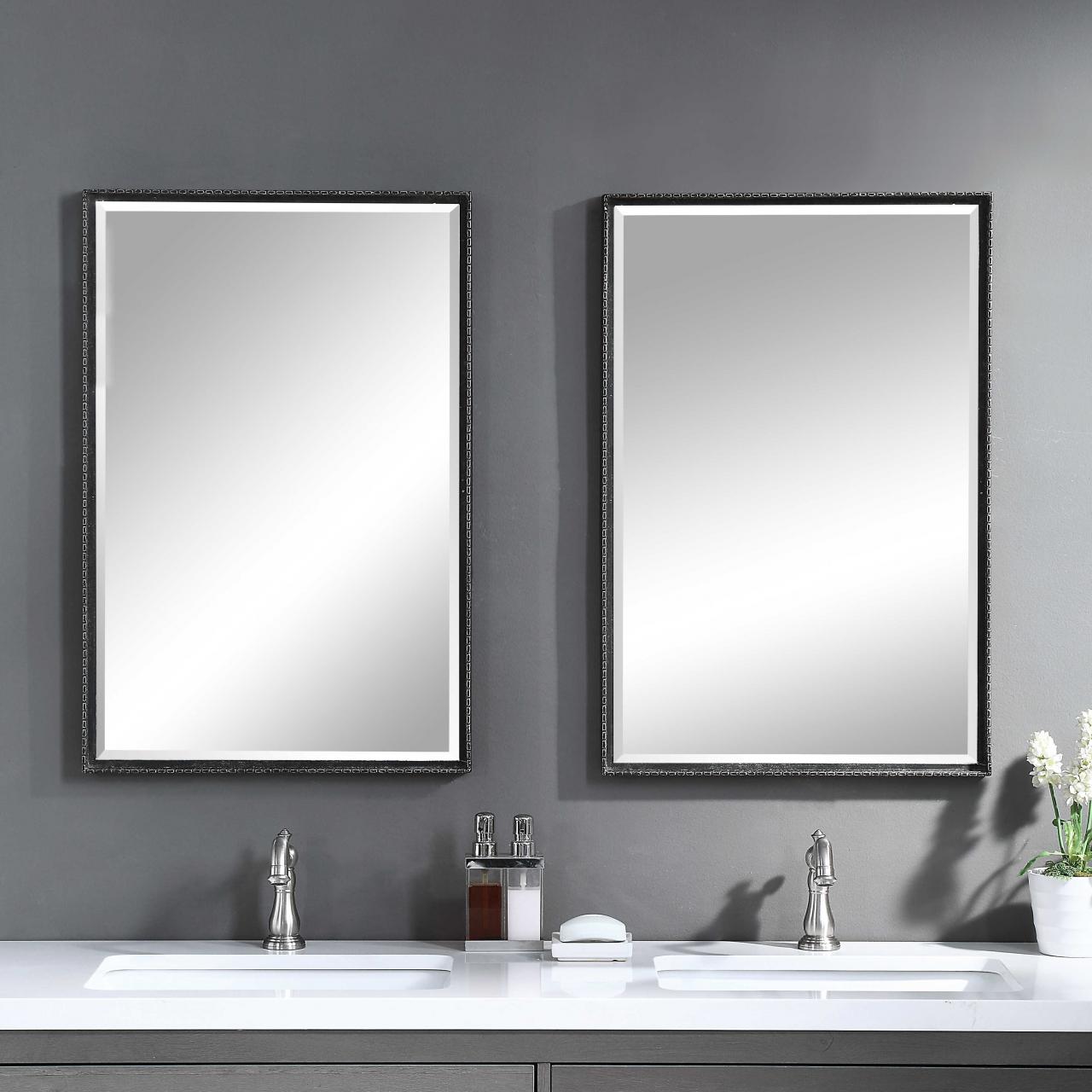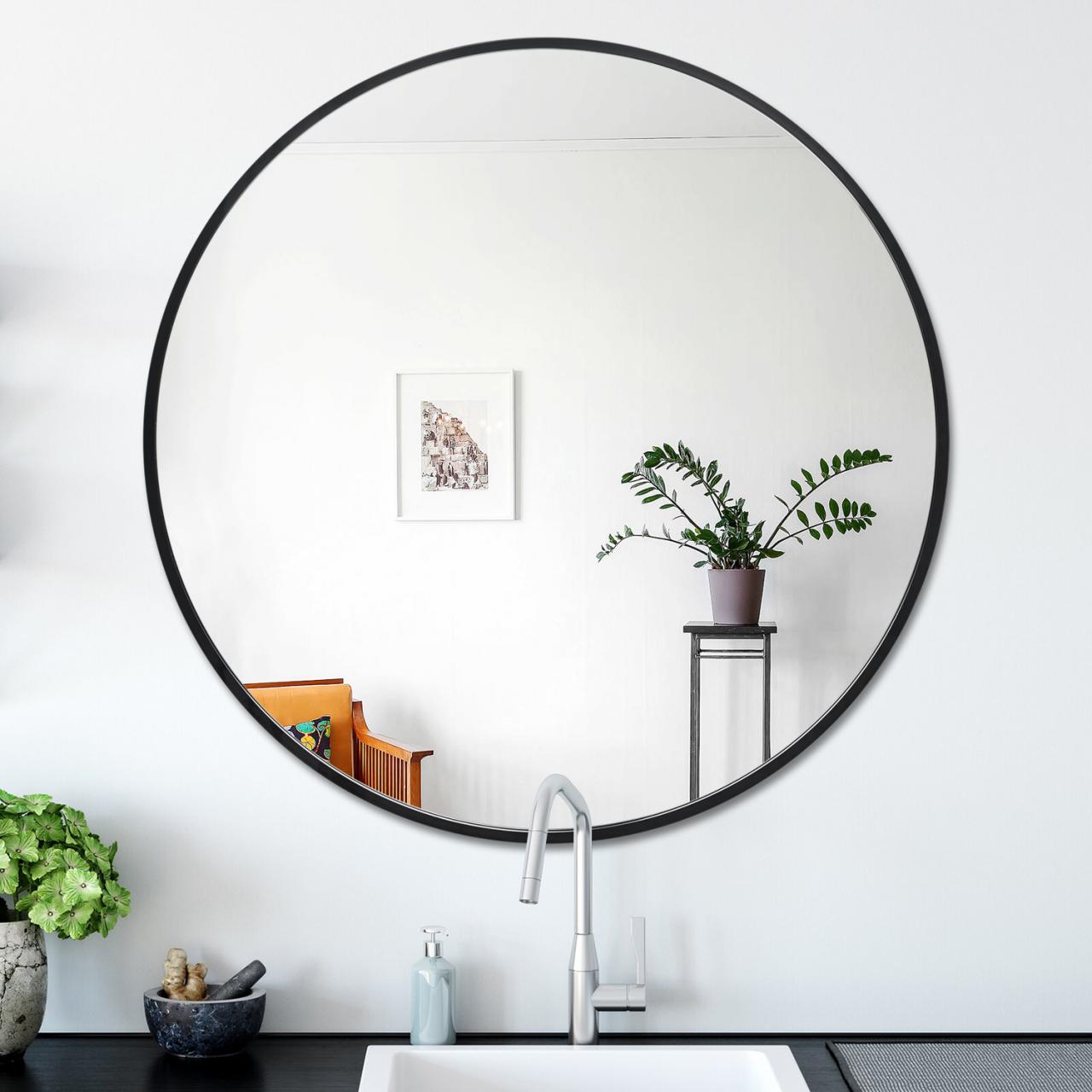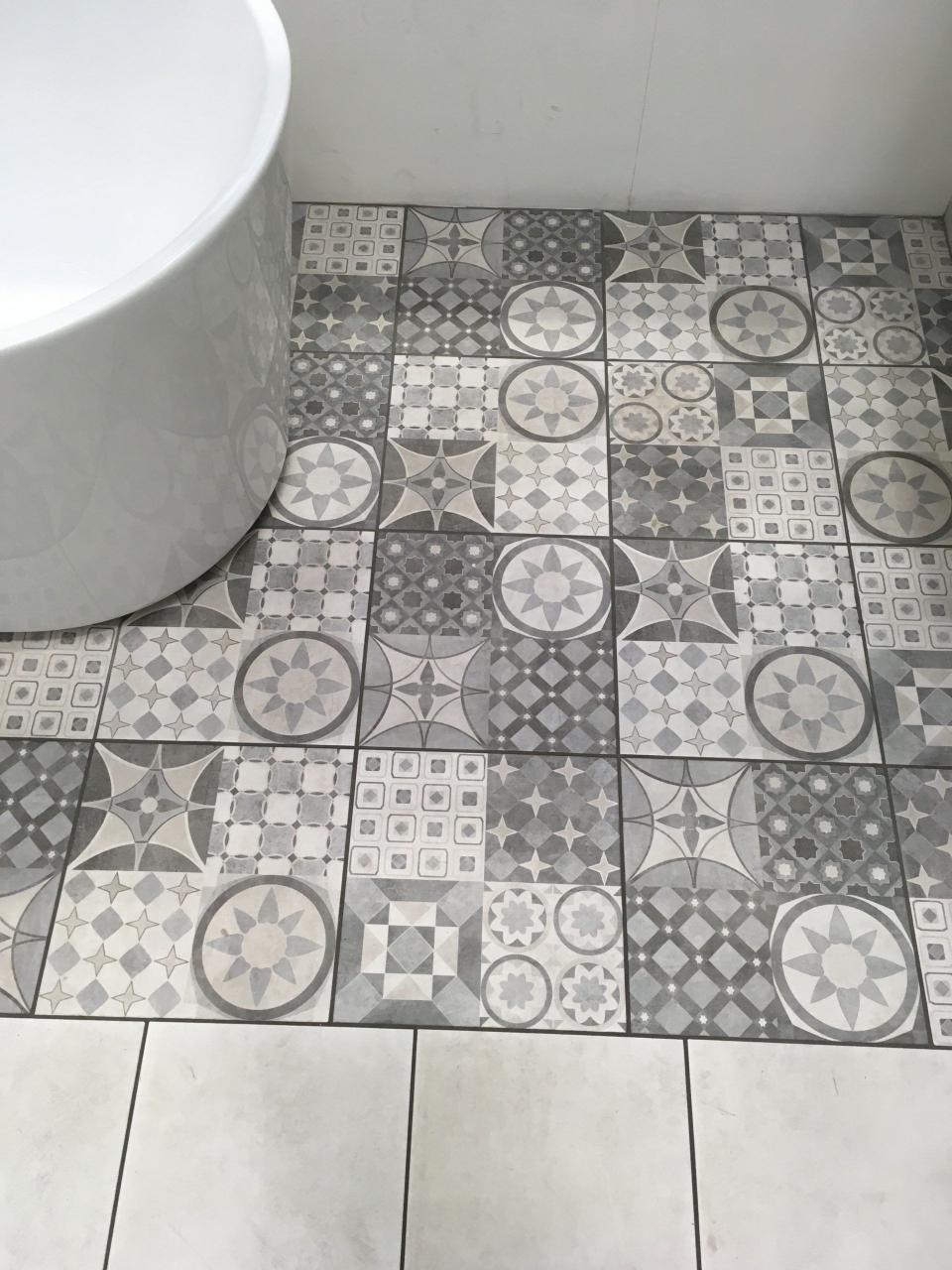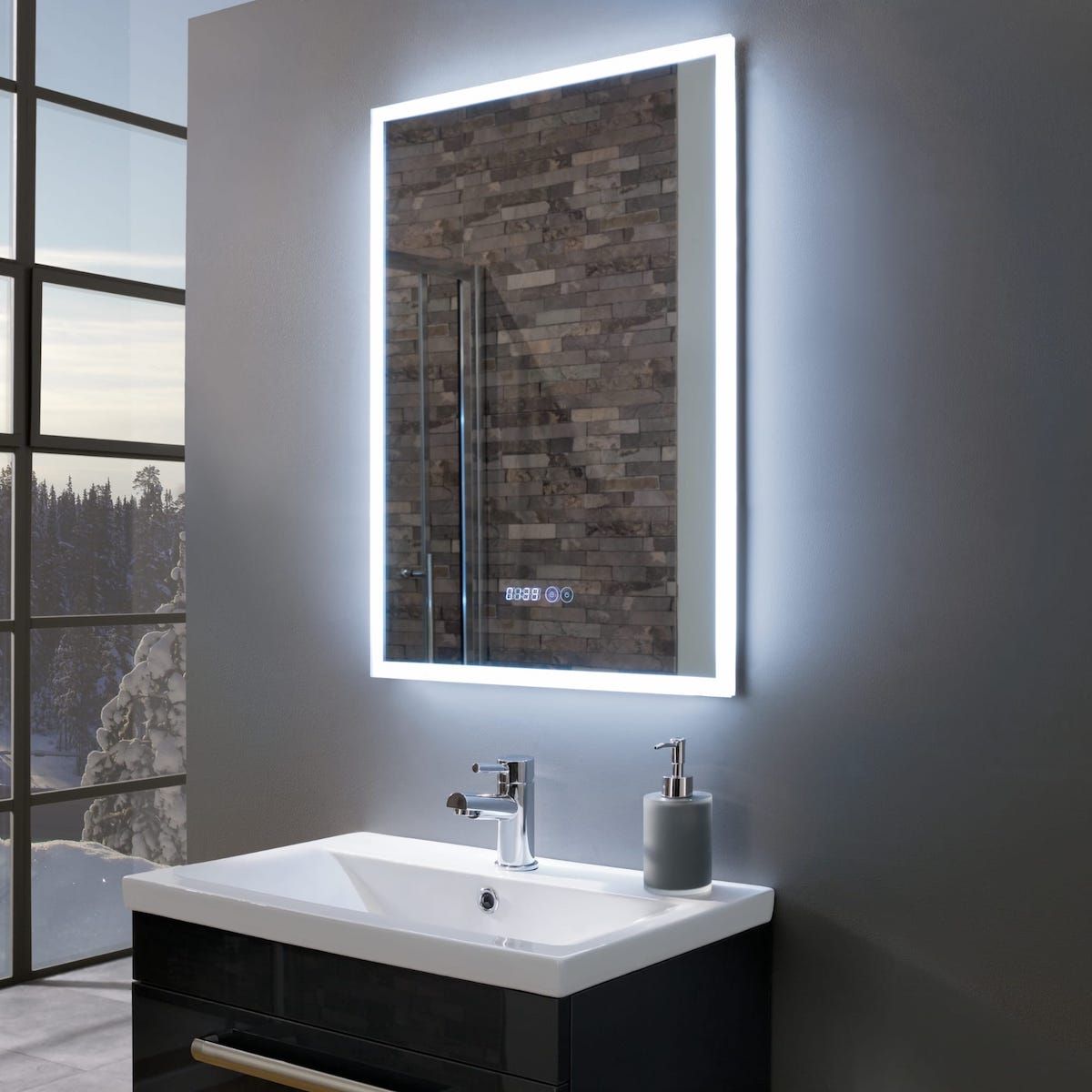Choosing the Perfect Bathroom Mirror Size and Shape
Finding the right bathroom mirror is crucial for both functionality and aesthetics. It can elevate your bathroom’s design while providing a practical space for daily grooming. To help you navigate the selection process, here are five essential tips to ensure you choose the perfect size and shape for your bathroom mirror.
- Proportion Matters: The size of your bathroom mirror should complement the vanity it hangs above. A good rule of thumb is to select a mirror that is about 70-80% of the width of your vanity. This creates a balanced appearance. If you have a double vanity, consider two smaller mirrors instead of one large one for added symmetry and visual interest.
- Hang at Eye Level: The height at which you hang your mirror is crucial for functionality. Aim for the center of the mirror to be approximately 60-65 inches from the floor. This height ensures that users can comfortably see their reflections. For bathrooms with tall or vaulted ceilings, a taller mirror can enhance the vertical space and draw the eye upward.
- Explore Shape Options:
Bathroom mirrors come in a variety of shapes, each offering its appeal. Rectangular mirrors are classic and versatile, while oval or round mirrors can add a touch of elegance or whimsy. Square mirrors provide a modern look, and for the adventurous, asymmetrical or uniquely shaped mirrors can serve as striking focal points. - Avoid Overwhelming Small Spaces: One common mistake is choosing a mirror that’s too large for a small bathroom. While larger mirrors can create the illusion of more space, they can also overwhelm a compact area. Opt for a mirror that fits comfortably within the wall space, allowing some breathing room around the edges for a more balanced look.
- Consider the Overall Flow: Think about how your mirror interacts with other bathroom elements such as lighting, cabinetry, and architectural features. A mirror that’s too tall may block light fixtures, while one that’s too wide might encroach on cabinetry. Ensuring that the mirror fits harmoniously within the space is key to achieving a cohesive design.
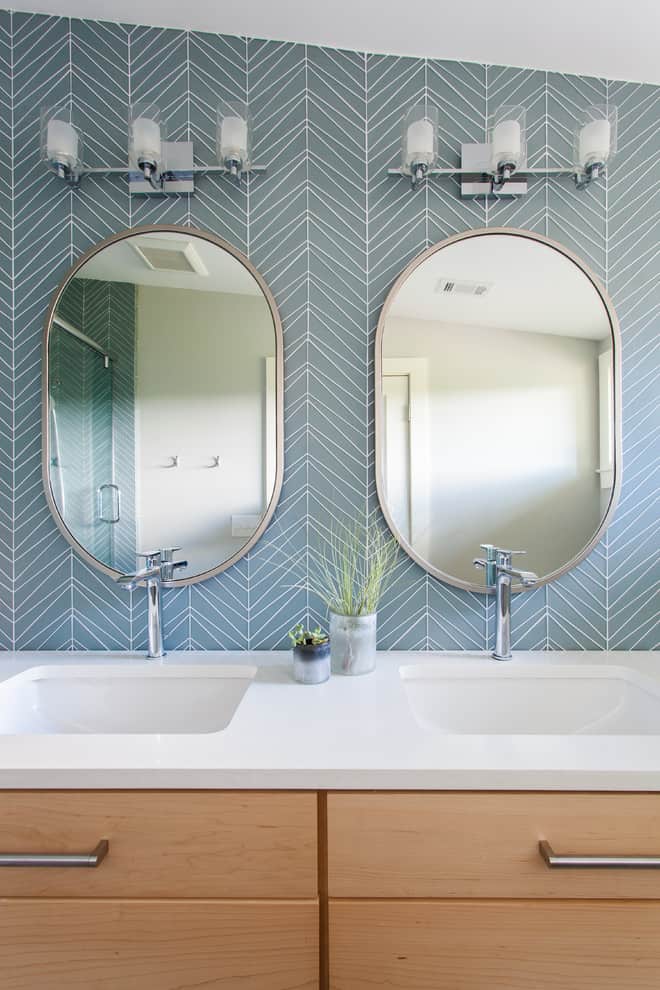
Frame Materials and Styles: Finding the Right Look
Once you’ve nailed down the size and shape of your bathroom mirror, it’s time to think about the frame. The frame is like the finishing touch that ties the whole look together, and it’s where you can let your personal style shine. I’ve always found that the right frame can transform a simple mirror into a statement piece that elevates the entire bathroom. Let’s explore some popular frame materials and styles to help you find the right look for your space.
One of the most classic and versatile options is a wooden frame. I love how wood can bring warmth and texture to a bathroom, especially if you have a lot of sleek, cold surfaces like tile and glass. Depending on the finish and wood type, a wooden frame can suit a range of styles—from rustic and farmhouse to modern and minimalist. For a cozy, traditional feel, go for a stained or natural wood finish. If you’re aiming for a more contemporary look, a painted or lacquered wood frame in a bold color might be the way to go.
Metal frames are another great option, particularly if you’re drawn to a more industrial or modern aesthetic. I’ve always admired the sleek, clean lines of a metal-framed mirror, which can add a touch of sophistication to any bathroom. Brass, chrome, and matte black are popular finishes that can complement various faucet and hardware choices. If you want to add a bit of glam, consider a metal frame with a brushed or antiqued finish—it’s a subtle way to introduce some luxury without going overboard.
If you’re looking for something a little more unique, consider a mirror with a frame made from unexpected materials like rattan, bamboo, or even concrete. These types of frames can add an eclectic or bohemian vibe to your bathroom, making it feel more personalized and less cookie-cutter. I’ve seen some beautiful rattan-framed mirrors that add an airy, tropical feel to the bathroom, perfect for creating a serene, spa-like atmosphere.
For those who prefer a minimalist look, a frameless mirror might be the best choice. I used to think that frameless mirrors were too plain, but I’ve since come to appreciate their simplicity and versatility. A frameless mirror can make a bathroom feel more open and uncluttered, which is particularly beneficial in smaller spaces. Plus, without a frame to compete with, the focus stays on the mirror’s reflection and the overall design of the bathroom.
Another consideration when choosing a mirror frame is how it will coordinate with other elements in your bathroom. I’ve found that it’s important to think about the finishes of your faucets, light fixtures, and cabinet hardware. For example, if you have brass fixtures, a mirror with a brass or gold-toned frame will tie everything together nicely. On the other hand, if you want a bit of contrast, you could mix finishes—just be sure to do so intentionally so it looks cohesive rather than mismatched.
Lastly, don’t be afraid to think outside the box when it comes to mirror frames. I’ve seen mirrors with frames that feature intricate carvings, mosaic tiles, or even backlighting that creates a halo effect around the mirror. These types of details can make your mirror a true focal point in the bathroom, adding character and personality to the space.
The Impact of Mirror Placement on Bathroom Design
Mirror placement is an aspect of bathroom design that often gets overlooked, but trust me, it’s just as important as choosing the right size, shape, or frame. The placement of your bathroom mirror can have a huge impact on the overall feel of the space, affecting everything from lighting to the sense of openness. Over the years, I’ve experimented with different mirror placements and learned a few tricks that can help you get the most out of your bathroom mirror.
The first thing to consider is the height at which you hang your mirror. I’ve found that the sweet spot is to place the center of the mirror at eye level for the average person, which is typically around 60-65 inches from the floor. However, if your household includes people of varying heights, you might need to adjust this a bit to ensure everyone can use the mirror comfortably. For instance, in my home, I’ve hung the mirror slightly lower to accommodate both adults and kids.
Another factor to think about is the distance between the mirror and the vanity. I’ve seen bathrooms where the mirror is placed too high or too low, which can create an awkward visual gap or make it difficult to use. Ideally, the bottom edge of the mirror should sit about 5-10 inches above the top of the vanity backsplash. This allows enough space for countertop items while keeping the mirror within a comfortable viewing range.
If you have a double vanity, you might be wondering whether to hang one large mirror or two smaller ones. I’ve tried both approaches, and each has its benefits. A single large mirror can create a more cohesive, unified look, while two smaller mirrors can add symmetry and give each sink its own defined space. Personally, I prefer the look of two mirrors because it adds a bit of architectural interest, but it really depends on the style and layout of your bathroom.
For those with limited wall space, like in a small powder room or a bathroom with lots of windows, mirror placement becomes even more critical. I’ve learned that in these situations, it’s best to get creative. You might consider placing a mirror directly opposite a window to reflect natural light and make the space feel larger. Alternatively, hanging a mirror on a side wall instead of directly above the sink can create an interesting visual effect and add depth to the room.
One of the most impactful placements I’ve tried is using a full-length mirror in the bathroom. While not as common as vanity mirrors, a full-length mirror can add a dramatic touch, especially in a larger bathroom or master suite. Placing it on a wall that’s visible as soon as you enter the bathroom creates a striking focal point and allows you to check your entire outfit before heading out the door.
Finally, consider how your mirror placement will interact with the lighting in your bathroom. I’ve found that placing a mirror near or opposite a light source, whether natural or artificial, can help brighten up the space and reduce shadows. However, be careful not to position the mirror where it will create unwanted glare or reflections. For example, if you have a light fixture directly above the mirror, make sure the light is diffused enough to prevent harsh shadows on your face.
Lighting and Mirrors: Enhancing Your Bathroom’s Ambiance
When it comes to creating the perfect bathroom, lighting is just as important as the fixtures and finishes you choose. But what many people don’t realize is how closely lighting and mirrors are connected. The way you light your bathroom mirror can dramatically affect the room’s ambiance, as well as your ability to see yourself. After experimenting with various lighting setups, I’ve discovered some key tips for pairing lighting with mirrors to enhance your bathroom’s overall vibe.
First and foremost, you want to avoid overhead lighting as the sole source of illumination near your mirror. I’ve found that overhead lights can cast unflattering shadows on your face, making it difficult to apply makeup or shave with precision. Instead, the best approach is to have lighting that flanks the mirror on either side. This creates even, balanced lighting that illuminates your face without casting harsh shadows. Wall sconces or vertical light bars are perfect for this and can add a touch of elegance to your bathroom design.
If you’re working with a small bathroom or a space with limited wall space, consider installing a mirror with built-in lighting. I’ve always admired the sleek, modern look of these mirrors, which often feature LED lights embedded around the edges. Not only do they provide excellent task lighting, but they also add a contemporary flair to the bathroom. Plus, many of these mirrors come with features like dimming options or color temperature adjustments, allowing you to customize the lighting to your liking.
Another important consideration is the type of light bulb you use. I’ve learned that the color temperature of the bulb can make a big difference in how you look in the mirror. For instance, bulbs with a color temperature of 2700K to 3000K (often labeled as “warm white”) create a soft, flattering glow that’s ideal for bathroom mirrors. On the other hand, “cool white” bulbs (4000K to 5000K) provide a brighter, more clinical light that’s better for tasks requiring precision, like grooming. I prefer warm white lighting for a more inviting, spa-like atmosphere.
If you’re fortunate enough to have natural light in your bathroom, you can use it to your advantage by strategically placing your mirror to reflect it. I’ve found that positioning a mirror opposite or adjacent to a window can help bounce natural light around the room, making it feel brighter and more open. However, be mindful of glare—if the sunlight is too direct, it can create harsh reflections that might be uncomfortable to look at. In that case, you might want to install a sheer curtain or blinds to diffuse the light.
Dimmers are another feature I highly recommend incorporating into your bathroom lighting setup. I’ve installed dimmers in my bathroom, and they’ve made a world of difference. With dimmable lights, you can adjust the brightness to suit different needs—bright light for tasks like shaving or makeup application, and softer light for a relaxing bath. It’s a small addition that offers a lot of flexibility and can enhance the overall ambiance of the bathroom.
Finally, don’t forget about accent lighting, which can be used to highlight architectural features or create a mood. I’ve seen bathrooms where LED strip lights are installed behind mirrors or under vanities, creating a subtle, glowing effect that adds depth and drama to the space. While accent lighting isn’t necessary, it’s a fun way to add a little extra personality to your bathroom and make it feel more luxurious.
Unique Mirror Features: Adding Functionality and Flair
When we think about bathroom mirrors, we often focus on their basic function—reflecting our image. However, mirrors can offer so much more than just a place to check your appearance. Over the years, I’ve discovered that mirrors with unique features can add both functionality and flair to a bathroom, turning a simple mirror into a multitasking powerhouse. Let’s explore some of the cool features you can find in modern bathroom mirrors that can take your bathroom to the next level.
One of the most popular features I’ve come across is the anti-fog mirror. There’s nothing more frustrating than stepping out of a hot shower only to find your mirror completely fogged up. I’ve dealt with this annoyance for years, and wiping the mirror down with a towel is never a perfect solution. That’s why I love the idea of a mirror with a built-in defogger. These mirrors use a gentle heating element to keep the surface clear, so you can see yourself immediately after a shower without any hassle.
Another feature that’s becoming increasingly common is integrated lighting. I’ve already mentioned how important lighting is in a bathroom, and mirrors with built-in lights take this to the next level. These mirrors often feature LED lights embedded around the edges or behind the glass, providing even, shadow-free illumination. I’ve seen some mirrors that even allow you to adjust the color temperature and brightness, so you can customize the lighting to match the time of day or your mood. It’s a fantastic way to combine form and function in one sleek package.
For those who love technology, smart mirrors are an exciting option. I have to admit, the idea of a mirror that can display the weather, time, or even stream music sounded a bit like science fiction to me at first. But after trying one out, I’m hooked! Smart mirrors can connect to your home’s Wi-Fi and sync with your smartphone, allowing you to access a range of features right from your bathroom mirror. Whether you want to check the news while brushing your teeth or control your bathroom’s smart lighting, these mirrors offer a level of convenience that’s hard to beat.
If you’re someone who’s always pressed for storage space, consider a mirror with built-in shelving or cabinets. I’ve always struggled with finding enough room for toiletries in my bathroom, so a mirror that doubles as a storage solution is a game-changer. These mirrors often feature hidden shelves or compartments behind the glass, where you can store everything from makeup to medicine. It’s a brilliant way to maximize space without sacrificing style.
Magnifying mirrors are another feature that can be incredibly useful, especially for tasks that require precision, like applying makeup or shaving. I’ve added a magnifying mirror to my bathroom, and it’s made a huge difference in my morning routine. Some mirrors come with a small magnifying section built into the main mirror, while others have an attached magnifying arm that you can pull out when needed. This added functionality is a lifesaver for anyone who needs a closer look at their reflection.
Last, let’s not forget about decorative features that can add a touch of flair to your bathroom mirror. I’ve seen mirrors with etched designs, beveled edges, or even backlit patterns that create a beautiful glow. These details can turn a plain mirror into a piece of art, making your bathroom feel more personalized and luxurious. While these features might not add functionality, they contribute to the overall aesthetic and ambiance of the space.
Mixing and Matching Mirrors with Other Bathroom Decor
Decorating a bathroom is all about creating a cohesive look that reflects your style, and mirrors play a significant role in that process. But what if you have multiple mirrors or want to incorporate other decorative elements? I’ve found that mixing and matching mirrors with other bathroom decor can be a fun and creative way to elevate the design of your space. However, it’s important to do it in a way that feels intentional rather than chaotic. Here’s how you can successfully mix and match mirrors with your bathroom decor.
The first thing to consider is the overall style of your bathroom. I’ve always believed that a bathroom should have a clear design theme, whether it’s modern, traditional, rustic, or eclectic. Once you’ve defined your style, it becomes easier to choose mirrors and decor that complement each other. For example, if you’re going for a rustic look, a wooden-framed mirror paired with natural elements like woven baskets or stone accessories will create a warm, cohesive vibe. On the other hand, if your bathroom has a modern aesthetic, sleek metal mirrors and minimalist decor will enhance that clean, contemporary feel.
Color is another critical factor when mixing and matching mirrors with other decor. I’ve learned that sticking to a consistent color palette can help tie everything together, even if the shapes and materials are different. For instance, if you have a white and gray bathroom, a silver-framed mirror will harmonize with chrome fixtures, while pops of color in your towels or artwork can add visual interest without clashing. If you want to introduce a bold color, try to repeat it in at least two or three elements in the room to create a sense of continuity.
Texture is an often-overlooked element, but it’s one of my favorite ways to add depth and interest to a bathroom. When mixing and matching mirrors with other decor, think about how different textures can complement each other. A rough, reclaimed wood mirror frame can contrast beautifully with smooth, glossy tiles, creating a dynamic, layered look. Similarly, a sleek, frameless mirror can provide a nice contrast to textured wall treatments like shiplap or patterned wallpaper. The key is to balance different textures so that the space feels rich and inviting rather than overwhelming.
Scale and proportion are also crucial when combining mirrors with other decorative elements. I’ve seen bathrooms where the mirrors are either too large or too small for the space, throwing off the balance of the room. When choosing mirrors, consider the size of your bathroom and the other items you plan to include. For example, a large mirror over a double vanity works well in a spacious bathroom, while a smaller, more delicate mirror might be better suited to a powder room. Additionally, if you’re hanging artwork or shelves near your mirror, make sure they’re in proportion to each other so that the arrangement feels balanced.
If you’re feeling adventurous, you can also experiment with mixing different mirror shapes and styles. I’ve seen some stunning bathrooms where round mirrors are paired with rectangular ones, or where a vintage mirror is combined with more contemporary pieces. The trick is to find a common thread that ties the different elements together, whether it’s the color, material, or overall vibe. For instance, if you’re mixing a round and a rectangular mirror, you could choose frames in the same finish, like black metal, to create a cohesive look.
Last, don’t forget about lighting when mixing and matching mirrors with other decor. I’ve noticed that the right lighting can make all the difference in how your mirrors and decor are perceived. Wall sconces or pendant lights that complement your mirrors’ style can enhance the overall ambiance and make the space feel more polished. If you have multiple mirrors, make sure each one is adequately lit so that they all contribute to the room’s brightness and functionality.
Common Mistakes to Avoid
When selecting a decorative bathroom mirror, there are several common mistakes that people often make, which can detract from the overall design and functionality of the space. First, choosing the wrong size mirror is a frequent error. A mirror that’s too small can look out of place and fail to provide adequate reflection, while an oversized mirror can overwhelm the space and throw off the room’s balance.
Another common mistake is neglecting to consider the mirror’s style to the rest of the bathroom decor. A mirror that clashes with the overall theme—whether it’s too modern for a traditional bathroom or too ornate for a minimalist space—can disrupt the room’s harmony. It’s important to choose a mirror that complements the existing design elements.
Improper placement is another issue to watch out for. Hanging a mirror too high or too low can make it difficult to use and can also affect the room’s proportions. Additionally, placing a mirror in a spot where it doesn’t receive adequate lighting can render it practically useless, especially in tasks that require good visibility.
Failing to account for moisture is a mistake that can lead to long-term damage. In a bathroom environment, mirrors are exposed to humidity and water splashes, which can cause certain materials to deteriorate. It’s essential to choose a mirror that’s designed to withstand these conditions, particularly if you’re opting for a framed mirror.
Last, overlooking the importance of functionality in favor of aesthetics can lead to regret. While a decorative mirror can be a beautiful focal point, it should also serve its primary purpose effectively. For example, a mirror with an intricate, heavily textured frame might look stunning, but if it obstructs your view or is difficult to clean, it may not be the best choice for a bathroom.
What’s the best way to clean a bathroom mirror without leaving streaks?
The best way to clean a bathroom mirror without leaving streaks is to use a mixture of equal parts water and vinegar. Spray the solution onto the mirror and wipe it clean with a microfiber cloth, which is less likely to leave lint or streaks behind. Avoid using paper towels or abrasive materials, as they can scratch the surface.
Can I hang a decorative mirror in a bathroom with high humidity?
Yes, you can hang a decorative mirror in a bathroom with high humidity, but it’s important to choose a mirror that’s designed to withstand moisture. Look for mirrors with moisture-resistant backing or frames made from materials like stainless steel, aluminum, or treated wood. Proper ventilation in the bathroom can also help reduce humidity levels and protect the mirror.
How do I choose the right size mirror for my bathroom vanity?
To choose the right size mirror for your bathroom vanity, consider the width of your vanity. A good rule of thumb is to select a mirror that’s slightly narrower than the vanity—typically about 2 to 4 inches less in width. This allows for a balanced look without the mirror overpowering the vanity. For height, consider the space between the top of the vanity and the ceiling or light fixture.
What type of lighting is best for illuminating a bathroom mirror?
The best lighting for illuminating a bathroom mirror is even, balanced light that reduces shadows. Side-mounted wall sconces or vertical light bars flanking the mirror provide excellent illumination. If space is limited, consider a mirror with built-in LED lighting. Opt for bulbs with a color temperature of around 2700K to 3000K for a warm, flattering glow.
Can I mix different mirror styles in the same bathroom?
Yes, you can mix different mirror styles in the same bathroom, but it’s important to maintain a cohesive look. Choose mirrors that share a common element, such as a similar frame finish, color, or shape, to tie the design together. Mixing styles can add visual interest, but be mindful of balance and proportion to avoid a chaotic appearance.
Are smart mirrors worth the investment?
Smart mirrors can be worth the investment if you’re looking for added convenience and functionality in your bathroom. They offer features like built-in lighting, touchscreen displays, and connectivity with other smart home devices. However, consider your budget and whether you’ll use the features regularly before investing. If you enjoy technology and want a modern bathroom, a smart mirror can be a great addition.
Wholesale Bathroom Mirrors
Wholesale Smart Home Decorative Oval LED Bathroom Mirror – China
Wholesale Uttermost Accent Furniture, Mirrors, Wall Decor, Clocks
Related Posts:
- Bathroom Mirror 72 X 42
- Lighted Bathroom Mirrors Wall
- 30 X 60 Bathroom Mirror
- Bathroom Mirror Light And Shaver Socket
- Bathroom Mirrors Louisville Ky
- Full Length Bathroom Mirror Cabinet
- Square Extendable Bathroom Mirror
- Where Can I Buy Bathroom Mirrors
- Bathroom Mirror Medicine Cabinet Modern
- Bathroom Mirrors Omaha
